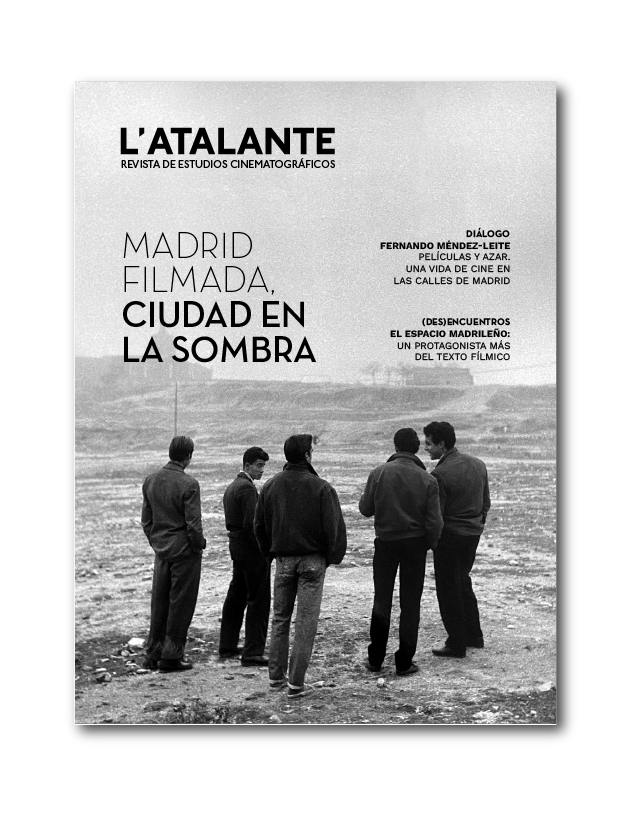Chicas de servir y señoritas de clase media en el Madrid predesarrollista. Saura y Patino en el IIEC
Publicado 31.07.2023
Palabras clave
- IIEC-EOC,
- Madrid,
- La tarde del domingo,
- Tarde de domingo,
- Basilio Martín Patino
- Carlos Saura,
- Predesarrollismo ...Más
Cómo citar
Derechos de autor 2023 L'Atalante. Revista de estudios cinematográficos

Esta obra está bajo una licencia internacional Creative Commons Atribución-NoComercial-SinDerivadas 4.0.
Resumen
La producción cinematográfica del Instituto de Investigaciones y Experiencias Cinematográficas (IIEC) y de su sucesora la Escuela Oficial de Cinematografía (EOC) ofrece, tanto en términos cuantitativos como cualitativos, un material de primer orden a la hora de estudiar cómo el cine español del periodo franquista ha representado la ciudad de Madrid. A partir del análisis pormenorizado de dos mediometrajes producidos por dicha institución, este artículo propone un primer acercamiento a un objeto de estudio (las relaciones entre Madrid y el IIEC-EOC) sobre el que necesariamente habrán de volver futuras investigaciones. Las similitudes entre La tarde del domingo (Carlos Saura, 1957) y Tarde de domingo (Basilio Martín Patino, 1960) no se circunscriben al título y a una premisa compartida, sino que alcanzan también al rol que desempeña la ciudad. Madrid es, en ambos relatos, un espacio hostil que funciona como una proyección de la angustia de las dos protagonistas. Pero mientras que en la práctica de Saura la amenaza de la ciudad tiene una encarnadura física (el agobio del tranvía, las luces de los escaparates, la actividad frenética…) en la de Patino Madrid es, sobre todo, un cúmulo de sensaciones, una experiencia mental antes que real.
Descargas
Citas
- Aranzubia, A., Castro de Paz, J. L. (2010). Desmontando el discurso televisivo: Luciano (Claudio Guerín Hill, 1964-65). Zer. Revista de Estudios de Comunicación, 15 (29), 13-30.
- Aranzubia, A. (2021). Cineasta a la vista. Berlanga en el IIEC. En J.L. Castro de Paz y S. Zunzunegui (eds.), Furia española. Vida, obra, opiniones y milagros de Luis García Berlanga (1921-2010), cineasta. Volumen I. El hombre y su obra (pp. 147-181). Valencia: Filmoteca Valenciana IVAC/Filmoteca Española.
- Aranzubia A., Aguilar S., Castro de Paz, J. L. (2022). El cine fantástico de la Escuela Oficial de Cinematografía. Matheson, Bradbury y Sheckley en Monte Esquinza. Arte, Individuo y Sociedad, 34(4), 1335-1351. https://doi.org/10.5209/aris.78592
- Berthier, N. (2017). Carlos Saura años cincuenta: en el principio era la fotografía. Atlante. Revue d’Études Romanes, (7), pp. 355-387.
- Deltell, L., García Sahagún, M. (2020). Escenarios de un remordimiento. Ciudad Universitaria y Guerra Civil en Muerte de un ciclista (Juan Antonio Bardem, 1955). Historia y comunicación social 25(2), 355-367. https://doi.org/10.5209/hics.72268
- Gorbman, C. (2007). Auteur Music. En D. Goldmark, K. Lawrence y R. Leppert (eds.), Beyond the Soundtrack Representing Music in Cinema (pp. 149-162). Berkeley: University of California Press.
- Pérez, L. (2016). Paseo por una guerra antigua (Juan Antonio Bardem, 1948-49): una contramemoria de la Guerra Civil. Área Abierta, 16(2), 41-53. https://doi.org/10.5209/rev_ARAB.2016.v16.n2.52065
- Pérez Millán, J. A. (2002). La memoria de los sentimientos. Valladolid: Semana Internacional de Cine de Valladolid.
- Sánchez Vidal, A. (1998). El cine de Carlos Saura. Zaragoza: Caja de ahorros de la Inmaculada.
- Vernon, K. M. (2021). Carlos Saura, ‘autor acústico’. En N. Berthier y M. Bloch-Robin (eds.), Carlos Saura o el arte de heredar (pp. 313-331). Valencia: Shangrila.
- Santesmases, M. (2021). Los inicios de Carlos Saura. Dos conversaciones. Getafe: TECMERIN/CRIMIC/Instituto del Cine.
- Wierzbicki, James (ed.) (2012). Music, Son and Filmmakers: Sonic Style in Cinema (pp. I-XV). New York: Routledge.
- Zunzunegui, S. (2005). Duende y misterio de Cesáreo González. En J.L. Castro de Paz y J. Cerdán (eds.), Suevia Films-Cesáreo González (pp. 155-195). A Coruña: Centro Galego de Artes da Imaxe.

